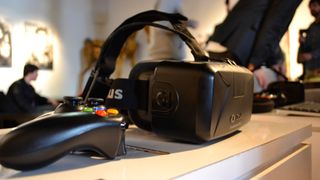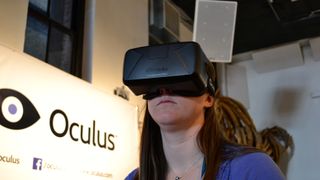Oculus Rift closer to consumers than ever before
DK2 headset isn't perfect, but it's almost there

How far Oculus Rift has come. From a cumbersome and latency lagged first dev kit to a sleeker and more engrossing Development Kit 2, the VR headset has been through a jet-propelled growth spurt over the last year.
The phenom isn't lost on Oculus VR CEO Brendan Iribe, who TechRadar went one-on-one with at GDC 2014.
"Twelve months ago, we were showing DK1 for the very first time," he recalled. "We didn't know what the community's reaction would be. We knew a lot of people were excited about it, but we just didn't know what their actual reaction would be when they tried it on. Everyone's excitement was really around the Kickstarter video, press and people saying, 'Oh my god, it's amazing.'"
The reaction, it turned out, was just what the Kickstarter campaign had foreshadowed. People lined up at GDC 2013 to try Oculus' take on virtual reality. While initial users were for the most part blown away, Iribe knew it could go further.
"We had people coming out going, 'Oh my god, this works. This is it.' And we're like, 'It's not really quite it yet. But it is a glimpse of it. A starting point.'"
"Twelve months later, we've addressed most of the biggest challenges to the vision side, which was positional tracking, really sub-millimeter positional tracking. I can move around and be comfortable in that movement. Your brain starts going, 'OK, OK, I'm moving correctly.' It's not going, 'No, don't do that, don't do that, that's horrible. Stay still, please stay still.' Then when you're looking and suddenly it all motion blurs and your brain is all, 'Oh! Maybe you don't want to move so much.'
"Suddenly you're back to being frozen. That's not virtual reality. Virtual reality is supposed to be this natural, comfortable ... you're in a new space [and] you get the sense of presence very comfortably."
Get daily insight, inspiration and deals in your inbox
Get the hottest deals available in your inbox plus news, reviews, opinion, analysis and more from the TechRadar team.

Getting there
A buzz phrase you'll hear around the VR world is "sense of presence," the feeling that you're actually in the realm your viewing through the headset. You should feel at ease and aware not of the thing strapped to your head, but of the molten hot lava flowing beneath your feet. Positional tracking is an integral part of convincing your brain you're somewhere else.
"We weren't there with the first developer kit, clearly," Iribe said. "We knew that, the community knew that. Everybody jumped in and got excited about it and started using it, but we all tried to be very transparent and set expectation that we were not there yet.
"With this second developer kit, we do try to set expectation. We're still not totally there yet, but this is a massive leap where we do have positional tracking. We've eliminated largely the motion blur. You can now track items and move around comfortably. We've increased the resolution and there's a lot less screen door."
Despite the improvements, Oculus Rift isn't where it needs to be for a public release.
"You can still see pixels - that's a problem," Iribe said of DK2. "Consumer product, you should not be able to see pixels. Seeing the pixels means you end up focusing on the screen, which breaks the experience and sense of presence. Suddenly, you're reminded that you are looking at a screen in front of your face.
"The goal is that, in the consumer product, you're going to be moving around and you're going to forget that it's on your face. You're going to forget that there's a screen in front of your face. We've seen this internally, some of the consumer prototypes where we have gotten where there isn't a screen door and you can't see the screen. We've seen people be in it, looking around, and just go, 'I really feel like I'm here,' and then going to wipe their nose and going [pretend whacking his hand up on his face], 'Gunk! I totally forgot I had this thing on.'"
Michelle was previously a news editor at TechRadar, leading consumer tech news and reviews. Michelle is now a Content Strategist at Facebook. A versatile, highly effective content writer and skilled editor with a keen eye for detail, Michelle is a collaborative problem solver and covered everything from smartwatches and microprocessors to VR and self-driving cars.

